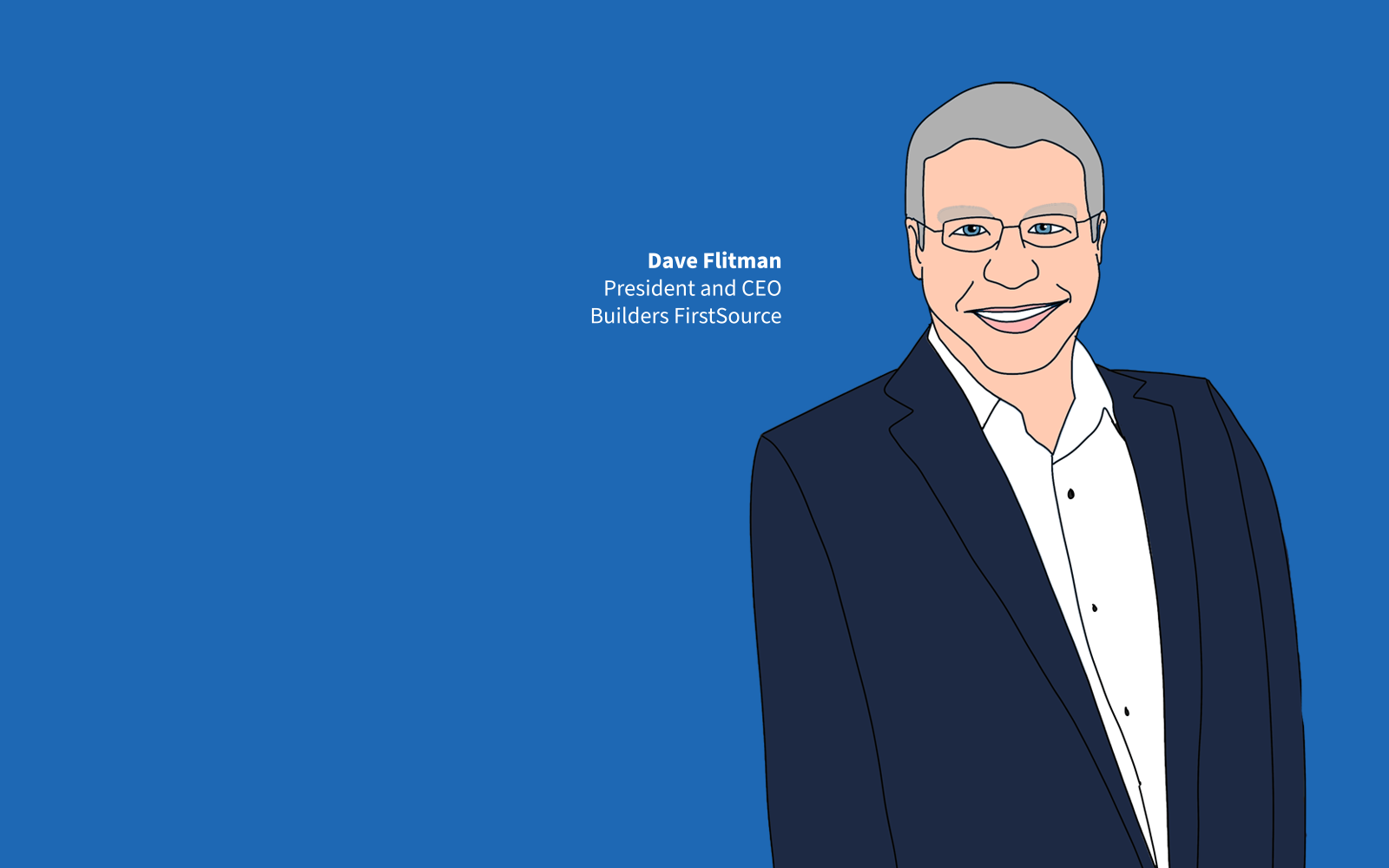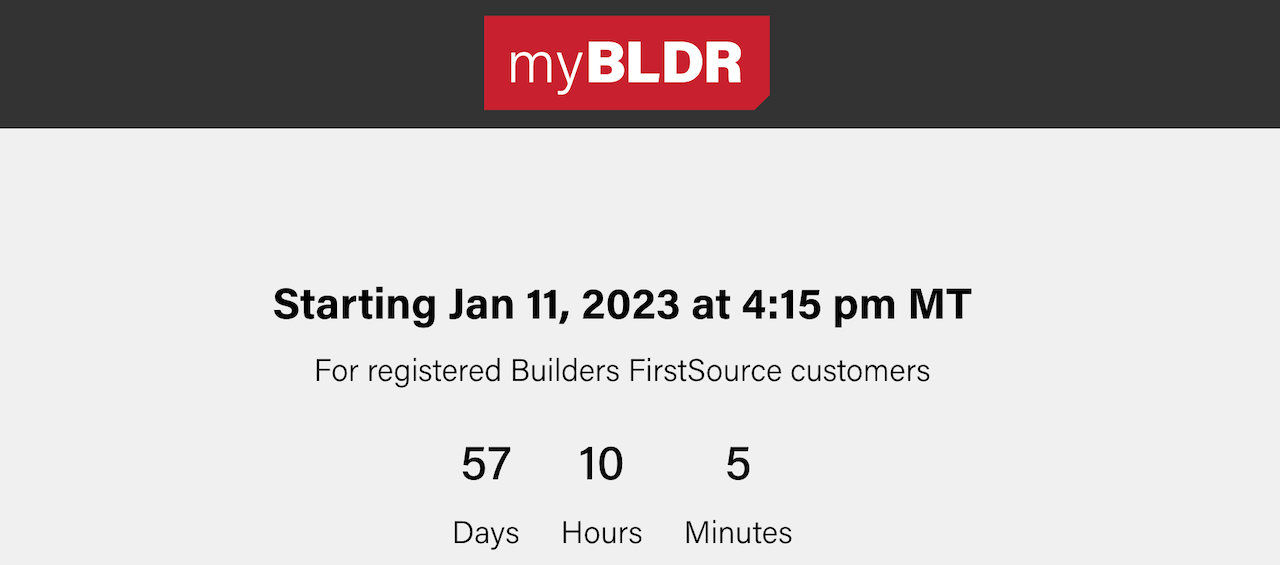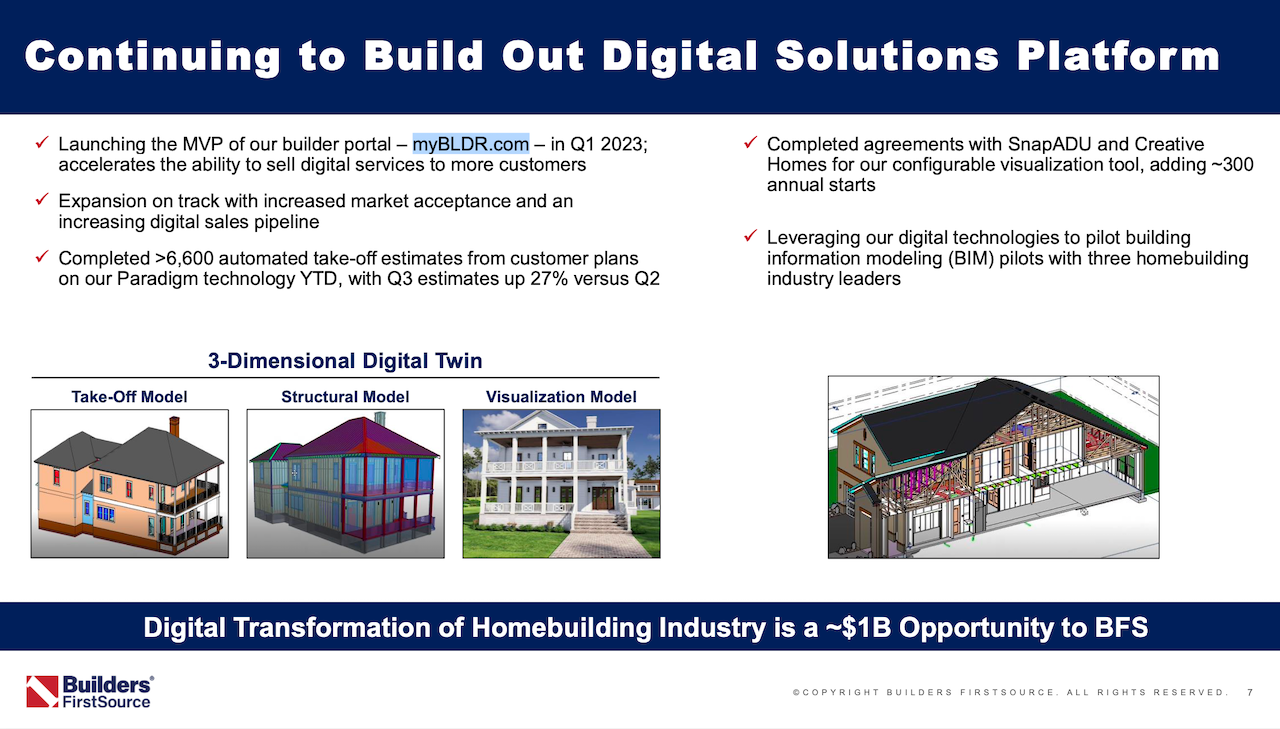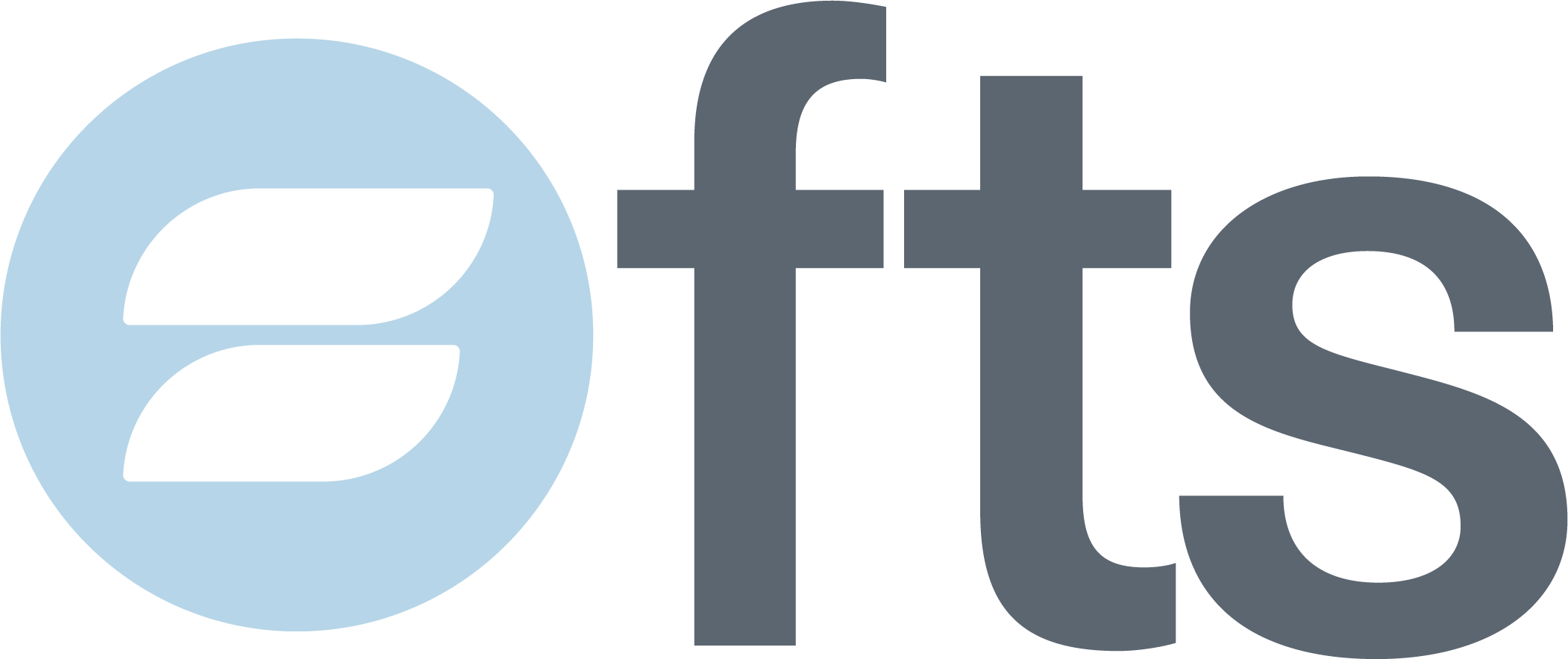Leadership
Now's No Time To Pause Push To Modernize Building: BFS' Flitman
With its countdown to a January 11, 2023 launch of its myBLDR.com platform, Builders FirstSource sets focus on its future in the face of near-term business headwinds.

Through crazy good times – and now on the verge of crazy challenging and adverse conditions – construction's grinding, sometimes frustratingly hesitant transformation to what it will someday be may hit speed bumps. But it goes on.
A whipsaw of moment and tumult plowed last week across sectors and domains that matter to us. The ultimate importance of all that high-decibel clamor – housing market, political, financial, tech, global, and environmental, to say the least – will filter through the immediate term noise and declare itself as fleeting or lasting.
What all of the attention-grabbing can't hide in this world of lives and livelihoods for people who make, and improve, and impact homes and communities is this: A cold, dark, tough winter lies ahead.
That's why this declaration from $20 billion construction channel bulwark Builders FirstSource, whose strategic leaders announced Q3 2022 earnings and spoke about them with investment analysts during last week's fray of moonshot meltdowns, crypto crashes, etc., strikes us as brilliant:

There are three reasons for this:
- Timing
- Focus, and
- The stuff and substance of forward investment and strategic commitment
Let's take each in context, and draw, verbatim, from commentary Builders FirstSource president and CEO Dave Flitman and CFO Peter Jackson added last week in response to equity research analysts' questions during the earnings call.
Timing
The pummeling effect of surging interest rates, falling home prices, 30% to 40% sales declines, a recently-spiking new force – professional-class layoffs, and increasing likelihood of a recession all portend hard months ahead.
Just how hard and just how many months are still unknown – pending inflation rate trends and the Fed's ongoing response to them.
What's clear – in the context of timing – are two crucial issues that make Builders FirstSource's countdown to January 11 a strategic masterstroke.
- Layoffs are inevitable, yet not entirely a negative, and what's more, do not stand in the way of a need to upskill and evolve human capability for the future as well as the present.
- Secondly, giving team members who survive reductions in force a bold, clear operational step-change moment ahead that all need to work for and all can ultimately take pride in commands attention as a positive beacon amid painful negatives. It signals investment in accelerated growth ahead in a current backdrop of necessary expense reductions during an indefinite period of slower, lower business volume.
Layoffs, both inside and outside of residential construction's market firmament are, and will continue to be, a big part of both the housing and broader economic outlook.
Already, mass layoffs in and among technology's up-to-now untouchables – Alphabet, Amazon, Meta/Facebook, Microsoft, and, of course, Twitter – have sent shock-waves into and beyond the Silicon Valley ecosystem and its macroeconomic impact:
Tech groups have announced 106,000 job cuts so far in 2022, according to Layoffs.fyi, a crowdsourced site that tracks redundancies in the tech industry. Lyft, Stripe, Snap and Twitter are among companies that are culling staff. Even those that have been relatively resilient — such as Apple and Alphabet — have paused or slowed hiring." – Financial Times
The comedown has been swift for employees of big technology companies, long among the most coveted workers in business. Accustomed to jobs with six-figure salaries, fat equity packages and cushy amenities, many employees are now facing staff cuts for the first time, along with shrinking net worths as stocks fall during a bumpy stretch for big tech." – The Wall Street Journal
What's more, a number of Wall Street investment and finance players have made or are making noises about "culling."
For companies like Builders FirstSource and for a great many homebuilding firms the implications of layoffs among high-paid tech and financial analysis talent cut two ways.
Employment destruction among upper tier earners who up to now dodged the impact of the shocks and aftershocks of the Covid pandemic would definitely hurt near-term housing market demand dynamics, both by putting stress on some households who're carrying hefty monthly mortgages, and by hitting future buyers in payment power and the job and income security front.
At the same time, the RIFs of Silicon Valley – coming as they are in the early stages of a data- and technological transformational moment of opportunity in construction – could be exactly the kind of break, from a talent standpoint, homebuilding companies and their construction and real estate partners could only ever have dreamt about.
The Financial Times piece notes:
Overall, the number of people employed in the tech industry has increased by 194,000 so far this year, according to an analysis of US jobs data by IT trade group CompTIA. Job postings for tech workers stood at nearly 317,000 in October, an increase of more than 10,000 from September. Some sectors are hiring heavily. Companies with the most tech job postings include defence contractors Boeing and Lockheed Martin and healthcare giants UnitedHealth and Humana
Some sectors are hiring heavily. Companies with the most tech job postings include defence contractors Boeing and Lockheed Martin and healthcare giants UnitedHealth and Humana.
A McKinsey analysis on both the opportunity and imperatives of companies that intend to withstand the punishment of cyclical downturns and an "economic winter" puts great emphasis on keeping a proactive stance on talent as both a survival and eventual thriving potential:
Our research indicates that talent pools in many industries are drying up as employees quit to enter other sectors, go after nontraditional opportunities such as gig-economy work, or leave the workforce altogether. Shortages of digitally savvy workers are especially acute: in our recent survey, nearly 90 percent of C-suite executives said they don’t have adequate digital skills.
Builders FirstSource strategists took pains to qualify that the company's own announcement of job cuts were a near-term response to business decline and operational excess in resources – a sign of a resilient balance sheet where 70% of corporate overheads qualify as variable expense that can be brought down as far as necessary "to flex with market conditions" and adjust to actual business volume levels – and at the same time a commitment to capability.
Here, direct from the Nov. 8, Q3 '22 earnings call transcript:
Dave Flitman – BFS president & CEO – on staff reductions
To this point, from the peak, we've taken out about 2,600 of our headcount [that peak being the end of the second quarter-early in the third quarter]. We have rationalized – or are in the process of rationalizing – 17 facilities... I want to be clear, we are not taking out manufacturing capacity. This is more consolidation primarily in some of the smaller markets where we may have redundant assets that given the last two years and the strength of the market, we have not needed to shut those facilities down. In fact, we've needed all that capacity that we've had, but times are different now. And so I really don't want to quantify any of that at this point. But as I said on the call, we will be proactive and decisive in actions given what happens in the marketplace.
The timing of the business model countdown to MyBLDR.com reflects a financial and strategic investment and commitment – one it hopes will galvanize not just its own team members and partners but its homebuilding customers with a simplifying capability that's part of what's needed to modernize a business with a few toes in the future and the rest of the anatomy in the comfort zone of the past.
FOCUS
BFS's go-big operational excellence play ties to its ability to activate more business opportunity across its 565 locations in 42 states and 85 of the top 100 markets by – simply – becoming indispensable to more builders and contractors. A host of businesses serving the builder-developer-remodeler community as an infrastructure or capability network are stacking various moving parts in the pre-start to completion build-cycle under one roof as an outsourced solution.
A core competency value proposition for homebuilders large, medium-sized, and small would create a simpler line of business strategy, lower fixed cost risks, and greater ability to make end-user customers the apex of the business value chain. This would contrast with today's much messier model of managing operational areas outside the zones of value, paying too much to do so, and risking losses or rigidity in times of cyclical change.
A year ago June, as we reported on BFS' $450 million deal to acquire Paradigm's digital take-offs platform based construction solution, we wrote:
Strategic investments that bring applied technology and data into play to augment – not replace – community members who bring value to construction's value chain, like LP Building Solutions investment in Entekra and Saint-Gobain brand CertainTeed's strategic partnership with Bensonwood, and PulteGroup's acquisition of Jacksonville, Fla.-based ICG, and Clayton Homes' roll-up of site-built operators to flank its empire of manufactured home facilities, reflect the beliefs of that other line of thinking.
Strategic infusions and partnerships like these reflect a conviction that better alignment – a bee-line from what consumers value back through the end-to-end building life cycle – not total reinvention will not only improve homebuilding and remodeling, but will improve homebuyer and residents' attainability and buying experience as well.
Poised as Builders FirstSource is to financially weather some rough-going ahead, the countdown to January 11, reflects a near- and long-term conviction that what the organization has begun in the way of modernizing its capabilities and elevating its partners' capacity to transform as well will continue to get fed and driven through the full downturn cycle ahead.

Dave Flitman – on investment in tech transformation
The end of the third quarter marks just over one year since the completion of our Paradigm and Apollo acquisitions. The original Paradigm business continues to perform exceptionally well and we are investing in the long-term growth of that business.
On the homebuilder software side, we remain committed to executing our development plan to build out of our digital sales team and integration with BFS operations. As we highlighted last quarter, we successfully integrated our structural design, material takeoff and visualization models into one streamlined process for our pilot customers. We now have 18 new digital sales representatives in place with more than 330 customer meetings held during the third quarter.
And we are excited to tell you about a new technology that we will be introducing to the marketplace at the beginning of 2023, our new mybldr.com website which will provide our small builder customers easy-to-use digital tools to virtually design and build their next home and engage with key operational functions, including planning, specifying products, ordering materials and budgeting. We believe our launch of this platform will help us grow the BFS brand and build on our momentum as the supplier of choice in the homebuilding industry.
Long-term strategic investment in technology
Cracking the code of the digitization of the start-to-complete build-cycle, its ability to port elegantly into construction documentation, virtual walk-throughs, and precision-manufacturing of construction components, panels, and modules is – as the slide above notes – a $1 billion upside "opportunity to BFS" its strategists believe.
The time to push forward – as they have in pilot projects with the likes of Century Communities, which is putting Paradigm's array of digitalization and automation solutions to work on one of its communities – is not after the cyclical swoon ahead, but now, according to Flitman.
Dave Flitman – on the commitment to push through change
We bought a platform that was -- we were very excited about with Paradigm, but it was very narrowly focused again on window and door manufacturers in the retail side of the business. And as we said, we've been investing heavily in the development of that platform to build it out to be able to handle the whole house design and configuration.
We're hitting a major milestone with that launch. And as we've said from the beginning, we are targeting this at the small builders first. So consistent with what we said, we're excited about that milestone. And there will be more to come over time. But 15, 16 months in, with the heavy lifting we have and continue to have on the development side, we're excited to bring that forward.
Dave Flitman – The 'Downturn Playbook' for a 20% starts drop
We do anticipate there to be declines on a number of different areas. We think starts will go down. We think commodities will continue to revert back to that long-term average. And we think there'll be some regression to the historical norms in margins. Beginning to see that in the third and fourth quarters and certainly expect that to play out through the year.
But it's an environment where even with those pretty significant slowdown estimates included in the metric, we're still at double-digit margins. We're still in a position where we've got a market-leading platform where we've got investments in value-add and digital and improvements internally and our productivity is helping to lead us through a very difficult time with a very profitable business."
Staffing and recruiting done right. Fast Tracking Solutions specializes in delivering top talent in accounting/finance, construction, and technology operations.
MORE IN Leadership
10 Bold Ideas Tackling Housing Affordability And Access Now
From AI to hempcrete, these 10 ideas show how innovation in design, finance, and policy can open the door to housing affordability.
Sumitomo Forestry Sharpens U.S. Focus With DRB Move
Strategic clarity replaces portfolio sprawl as Sumitomo bets big on U.S. scale and integration.
Homebuilders and Insurance: A New-Reality Cost To Stay Ahead
Exclusive insights from Westwood Insurance Agency’s Alan Umaly and MSI’s Naimish Patel reveal why homebuilders must rethink insurance, resilience, and risk management—or risk losing buyers in an increasingly volatile market.


